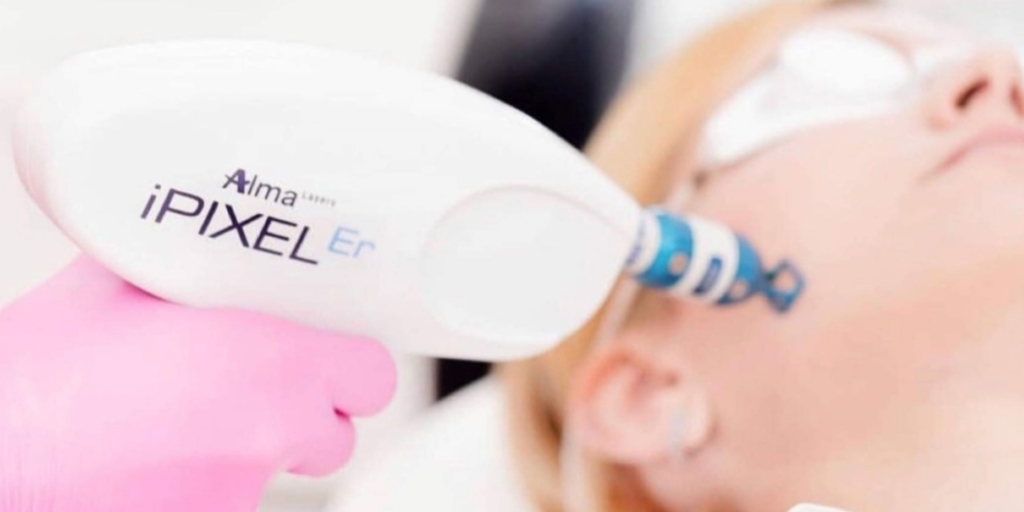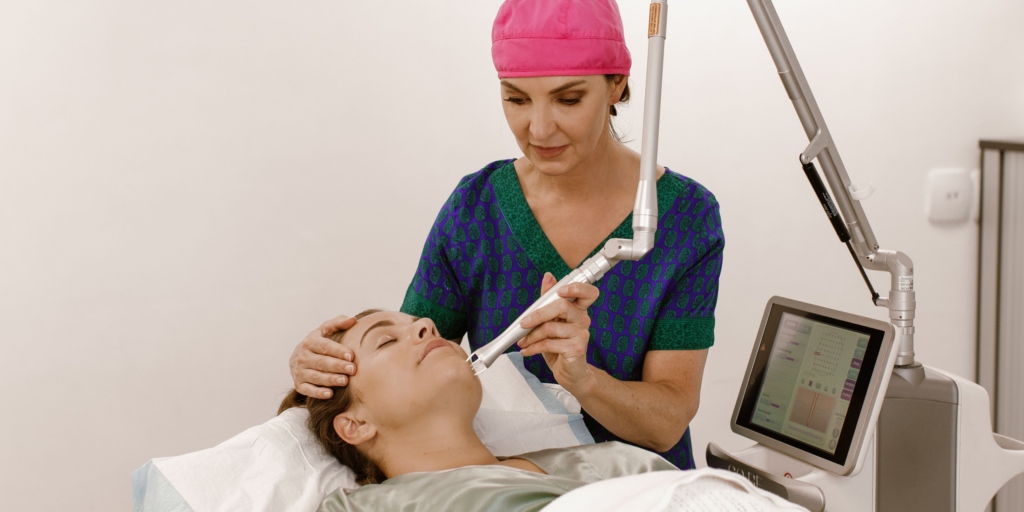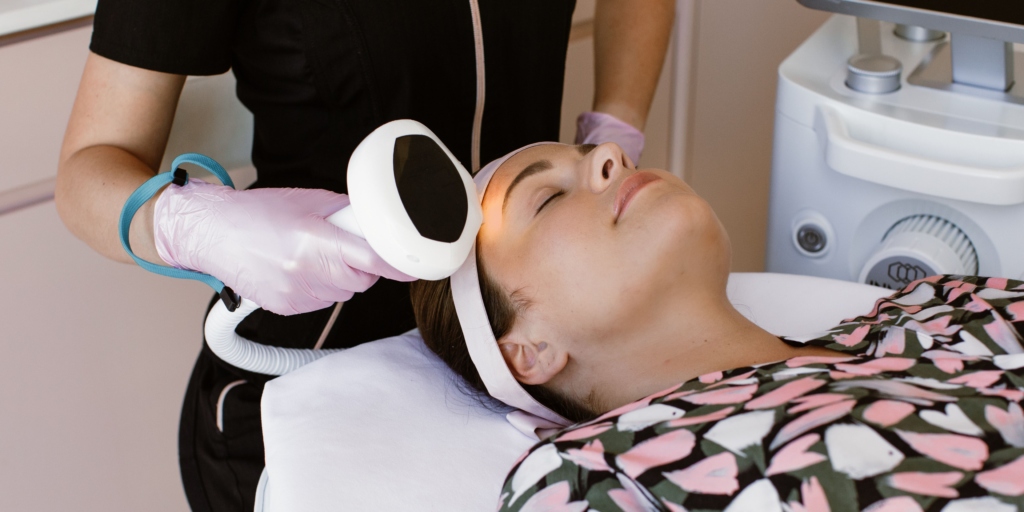by Skincare Specialist, Bianca Jansen
Skin lasers have revolutionized the field of facial and body aesthetics by offering versatile and effective solutions for a wide range of skin issues. With their precise and targeted approach, laser technology has transformed the way cosmetic surgeons and aesthetic practitioners address various concerns, providing patients with safer and more efficient treatments. From resurfacing and rejuvenating the skin to treating scars, pigmentation, and even tattoo removal, skin lasers have become indispensable tools in the world of skin rejuvenation.
There are various types of skin laser treatments available today, each designed to address specific concerns. Fractional laser treatments, such as Erbium:YAG and CO2 lasers, are used for skin resurfacing and rejuvenation. Q-Switched Nd:YAG lasers are versatile and commonly used for tattoo removal, pigmentation issues, and skin rejuvenation. Intense Pulsed Light (IPL) treatments use broad-spectrum light pulses to address multiple skin conditions simultaneously, including pigmentation, redness, capillary damage, and mild acne scars.
This blog post aims to provide a detailed exploration of skin laser treatments, showcasing their revolutionary impact on cosmetic skincare and surgery. It offers a comprehensive understanding of the various types of laser treatments, their specific applications, and the benefits they provide.
The post goes beyond a surface-level overview by delving into the ultimate guide to skin lasers, explaining their technology and how they interact with the skin to achieve desired results.
Table of contents
- Understanding skin laser treatments
- What are skin lasers?
- The different laser therapies and concerns they target
- Potential risks and complications associated with skin lasers
- Choosing the best skin laser treatment
- How to prepare for laser treatments
- Skin laser aftercare
- Final thoughts on skin lasers
Understanding skin laser treatments
Skin lasers are advanced medical devices that use focused beams of light to treat various skin conditions and concerns. These lasers emit specific wavelengths of light that are absorbed by the target tissue in the skin, allowing for precise and targeted treatment. The light energy is converted into heat, which can selectively damage or destroy specific skin components, such as pigmentation, blood vessels, or collagen while leaving the surrounding healthy tissue unharmed.
What are skin lasers?
Skin lasers work on a cellular level to rejuvenate the skin by utilizing their ability to stimulate collagen production. Collagen is a crucial protein that provides structural support to the skin, contributing to its strength, elasticity, and overall youthful appearance. As we age, the production of collagen naturally declines, leading to the formation of wrinkles, fine lines, and a loss of skin firmness.
Skin lasers effectively address these concerns by targeting the deeper layers of the skin and triggering collagen synthesis through controlled thermal injury or fractional resurfacing.
The different laser therapies and concerns they target
There is a wide variety of laser therapies available to address specific skin concerns.
Ablative lasers vaporize the outer layers of the skin and are effective for treating deep wrinkles, severe acne scars, and skin irregularities. Non-ablative lasers heat the deeper layers of the skin to stimulate collagen production and tighten the skin, making them suitable for mild to moderate wrinkles and acne scars. Fractional lasers deliver laser energy in a fractional pattern, promoting faster healing and addressing concerns like wrinkles, acne scars, pigmentation issues, and uneven skin tone.
In addition, Q-Switched lasers are high-powered lasers used for tattoo removal and treating pigmented lesions. They shatter pigment particles into smaller fragments for natural elimination. Nd:YAG lasers emit a longer wavelength of light, allowing them to safely penetrate deeper layers of the skin. They are commonly used for hair removal, vascular lesion treatment, and skin rejuvenation. We’ll cover these and examples of each in detail below.
These advancements in laser technology provide personalized treatment options for different skin concerns and treatment objectives.
Ablative lasers and their benefits
The Erbium iPIXEL Pro
The Erbium iPIXEL Pro is one of our favourite ablative lasers and is an advanced laser treatment that specifically targets skin texture irregularities, as well as pigmentation and sun damage. It is a fractional ablative laser system that utilizes the Erbium:YAG laser technology for precise and effective skin rejuvenation.
Here are some key features and benefits of the Erbium iPIXEL Pro:
Skin Texture Improvement: The laser energy is absorbed by the water content in the skin, causing controlled vaporization of the outer layers. This process promotes the removal of damaged skin cells and stimulates the production of new collagen and elastin fibers. As a result, the skin’s texture becomes smoother, fine lines and wrinkles are reduced, and overall skin tone and elasticity are improved.
Pigmentation and Sun Damage Treatment: The laser energy breaks down excess melanin, which is responsible for pigmentation irregularities such as sunspots, age spots, and freckles. Over time, as the treated skin heals, the pigmentation fades, resulting in a more even skin complexion.
Reduction of Wrinkles and Fine Lines: By precisely targeting the damaged skin cells, the laser stimulates collagen production and promotes skin regeneration.
Acne Scar Reduction: By resurfacing the skin and stimulating collagen production, the laser helps to remodel the scar tissue and improve the texture and smoothness of the skin.
Pore Size Reduction: Reduce the size of enlarged pores by stimulating collagen production and tightening the skin. As the skin becomes firmer the appearance of large pores are minimized.
Can you tell why it is one of our most popular treatments?
Non-ablative lasers and their benefits
This is a laser treatment used to target specific skin concerns without removing or ablating the outer layers of the skin. Non-ablative lasers work by delivering laser energy to the deeper layers of the skin while leaving the surface intact, this makes non-ablative laser treatments more gentle with minimal downtime. Let’s explore their applications in skincare:
Skin Rejuvenation: Non-ablative lasers stimulate collagen production in the deeper layers of the skin without causing visible damage to the surface. By promoting collagen synthesis, non-ablative lasers improve skin elasticity, texture, and tone.
Pigmentation Correction: They work by selectively heating and breaking down the pigmented cells or melanin clusters.
Vascular Lesion Treatment: The laser targets and coagulates the blood vessels responsible for conditions such as spider veins, broken capillaries, and vascular birthmarks. The laser energy is absorbed by the blood vessels, causing them to collapse and fade over time.
Scar Reduction: By stimulating collagen production, the laser helps remodel the scar tissue, leading to a smoother and more even skin texture. While they may not completely remove deep or severe scars, non-ablative lasers can significantly improve their appearance and minimize their visibility.
The ClearLift by Harmony XL Pro
The ClearLift by Harmony XL Pro is a great example of a non-ablative laser that focuses on helping patients age gracefully. It is known as the “Lunchtime Facelift” and utilizes non-ablative laser technology by delivering controlled energy pulses deep into the skin. This process stimulates collagen production and remodeling, resulting in tightened skin, and reduced wrinkles and fine lines.
The treatment promotes cellular turnover, improves skin tone and texture, and reduces the appearance of pores, providing a smoother and more refined look. Importantly, ClearLift achieves these benefits with minimal downtime, making it an effective and convenient option for rejuvenation.
Fractional laser treatments and their benefits
One of the significant benefits of fractional laser treatments is their ability to stimulate collagen renewal, leading to improved skin texture and overall skin health. The laser energy targets the damaged skin cells, encouraging them to shed and be replaced by new, healthier cells. As collagen is stimulated and new skin cells are generated, the overall texture of the skin becomes smoother and more even.
Fractional lasers are a more intensive approach to rejuvenation and are particularly beneficial for addressing rough skin, acne scars, and areas of uneven texture, resulting in a more refined and youthful complexion.
The CO2RE Fractional Laser
The CO2 fractional laser treatment is a popular and effective procedure used to treat various skin conditions. It works by emitting laser energy in a fractionated pattern of microscopic beams. These beams create tiny, controlled channels of thermal injury in the skin. The surrounding healthy tissue remains intact, which aids in the healing process and reduces downtime. The laser energy is absorbed by the water content in the skin cells, causing the targeted tissue to vaporize and stimulating the production of new collagen.
Fractional laser treatments also target excess melanin in skin cells, breaking it down and dispersing it, resulting in lighter and more even pigmented areas over time. Additionally, the treatment offers skin resurfacing benefits by promoting collagen remodelling, shedding damaged skin cells, and promoting the growth of healthier skin.
This process significantly improves skin texture, reduces scars and roughness, and enhances overall skin quality.
Q-Switched Nd:YAG laser treatments
Q-Switched Nd:YAG lasers are characterized by their short pulse duration and the use of neodymium-doped yttrium aluminum garnet as the laser medium. It is highly effective in treating pigmentation issues by targeting and breaking up pigmented cells. It is also considered the gold standard for tattoo removal as it fragments ink particles for gradual fading.
Additionally, Q-Switched Nd:YAG lasers promote collagen remodeling and tightening for skin rejuvenation. This laser can be used on all skin types with minimal risk of pigmentation changes or damage. Multiple sessions are usually required for optimal results, spaced several weeks apart.
By simply using a different specialised tip, the ClearLift by Harmony XL Pro (as mentioned above) becomes a world-class Nd:YAG laser!
Intense pulsed light treatments and their benefits
Intense Pulsed Light (IPL) treatments are non-invasive cosmetic procedures that use a broad spectrum of light wavelengths to address various skin concerns. By targeting chromophores like melanin and haemoglobin, IPL treatments can effectively treat sun damage, pigmentation issues, rosacea, vascular lesions, acne, acne scars, uneven skin texture, and fine lines. The light energy is absorbed by these chromophores, converting it into heat and stimulating collagen production.
This leads to skin rejuvenation, improved texture, and a more youthful appearance. IPL treatments are versatile and can address multiple concerns simultaneously, making them a popular choice for non-invasive skin rejuvenation.
Lumecca IPL
The light energy delivered by LUMECCA™ IPL (our intense pulsed light device of choice) gently heats the upper layers of the skin. The heat is absorbed by the target areas and will stimulate the skin cells to regenerate. LUMECCA™ IPL (intense pulsed light) offers a superior solution (being the most powerful IPL technology available today) to improving skin complexion and reducing skin irregularities – resulting in clearer, smoother, and younger-looking skin.
With LUMECCA IPL, light energy penetrates the dermis and is converted into heat energy. The heat causes controlled inflammation within the dermis after which the skin responds by releasing regenerative growth factors. Fibroblasts are also stimulated and produce new collagen and elastin, giving the skin a lifting and tighter effect.
Potential risks and complications associated with skin lasers
Laser treatments for skin, while generally safe and effective, carry potential risks and complications, and it is important to be aware of them.
Temporary redness, swelling, and discomfort are common after laser treatments. There is a risk of temporary or permanent changes in skin colour, especially for individuals with darker skin tones. Burns, scarring, and the possibility of infection exist but can be minimized with proper precautions.
It is also important to know that the effectiveness of laser treatments and individual responses can be influenced by various factors. Skin type, which affects melanin levels, can impact how the skin absorbs and reacts to laser energy.
The severity of the skin condition being treated also plays a role, with mild concerns responding more readily compared to deeper or advanced conditions. The body’s response to treatment, including natural healing ability, collagen production, and overall skin health, can also affect outcomes.
Compliance with the recommended treatment plan, including sessions and care instructions, is also crucial for optimal results. Some skin concerns may require maintenance treatments over time, especially for conditions influenced by aging, sun exposure, or hormonal changes.
Choosing the best skin laser treatment
When selecting a laser treatment, it is crucial to understand and consider individual skin concerns and objectives. Each person’s skin is unique, with specific conditions and desired outcomes. Personal research, professional consultations, and a thorough evaluation of one’s skin condition are important for making an informed decision.
Disclosing relevant information to your treating professional, such as skin care routines, medications, allergies, and previous treatments, is important to ensure informed decisions and minimize risks or contraindications.
The experience and credibility of the cosmetic surgeon or skincare specialist are vital for the effectiveness and safety of laser treatments. Assessing qualifications, previous work, patient testimonials, and the approach of the professional is essential in selecting the right provider for optimal care. A skilled professional will take a personalized approach, carefully assessing your skin condition, listening to your concerns and objectives, and developing a customized treatment plan tailored to your specific needs.
Selecting the right laser treatment requires considering multiple factors. Skin conditions, skin type, desired results, and recovery time are crucial considerations. Different laser treatments target specific concerns, so identifying your specific skin condition with an experienced professional is of utmost importance.
How to prepare for laser treatments
Consulting with a cosmetic surgeon or skin specialist before undergoing laser treatment is essential. These professionals possess the necessary expertise and experience to provide guidance and ensure the safety and effectiveness of the treatment.
The consultation process allows for a thorough evaluation of your specific concerns, helping determine the most suitable laser treatment for your needs. A personalized treatment plan is created based on this evaluation, targeting your specific concerns and optimizing the outcomes. During the consultation, various treatment options will be discussed, including their benefits, associated risks, and limitations, and exactly how you need to prepare your skin before your first appointment.
Skin laser aftercare
Following post-treatment care instructions is crucial for optimal healing and results after a laser treatment. These instructions include applying prescribed creams or ointments to soothe the skin and promote healing.
Protecting the skin from sun exposure by using a broad-spectrum sunscreen is just as important, as the treated skin is more sensitive.
With all laser treatments, harsh skincare products should be avoided, as they may irritate the skin.
Activities generating excessive heat should also be avoided as this might interfere with your desired results.
Last but not least, hydration and nourishment are essential for supporting the skin’s recovery and promoting cell regeneration. Maintaining proper hydration helps restore the skin’s natural moisture balance and aids in repairing damaged skin cells.
Final thoughts on skin lasers
Skin laser treatments have revolutionized cosmetic surgery and dermatology by offering transformative results for various skin concerns and skin types. Advances in technology allow us to offer non-surgical, minimally invasive options with personalised treatment plans and minimal downtime.
Remember, choosing a qualified and experienced professional is crucial for safe and effective outcomes. A skilled practitioner will evaluate your skin, listen to your goals, provide transparent advice, and ensure your safety and treatment effectiveness.
Should you be ready to make a change, email us at skinclinic@drnwilkinson.co.za to start your Skin Science journey to radiance today.








